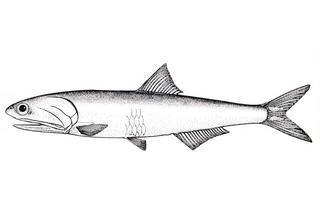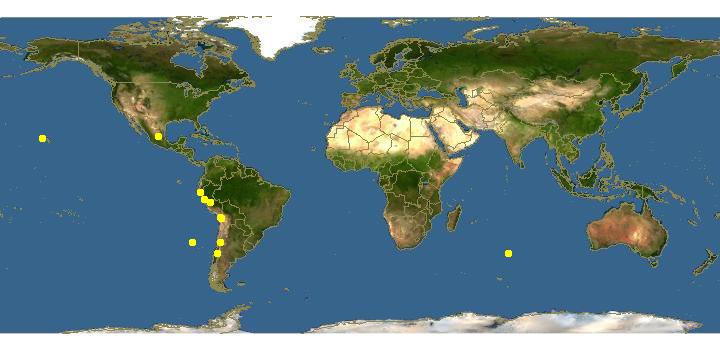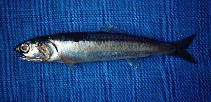
www.fao.org Copyright Michel Lamboeuf · 0
Engraulis ringens |

Click on map for details about points.
|
| Links |
We parsed the following live from the Web into this page. Such content is managed by its original site and not cached on Discover Life. Please send feedback and corrections directly to the source. See original regarding copyrights and terms of use.
- FishBase
|
|
espa˝ol |
|
|
Overview |
Main identification features
- top jaw reaches front preopercle
- lower jaw tip before nostril
- anal fin origin well behind dorsal fin
Body slender, elongate, rounded; snout long and sharply pointed; top jaw relatively short, reaching only to front of preopercle, tip blunt; lower jaw reaching before nostil; no large canine teeth; membrane between gill covers not expanded at rear; third gill arch without rakers; 38-49 long, slender rakers on lower limb of first gill arch; dorsal fin origin in mid-body; anal fin base short, 18 rays, origin well behind last dorsal ray.
Silver stripe along flank in young fish only.
Size: to 24 cm.
Habitat: marine, coastal pelagic, usually within 80 km of shore.
Depth: 0-50 m?.
Ecuador to Chile, Galapagos as a vagrant.
Attributes
Abundance: Common.
Cites: Not listed.
Climate Zone: Equatorial (Costa Rica to Ecuador + Galapagos, Clipperton, Cocos, Malpelo); South Temperate (Peruvian Province ).
Depth Range Max: 50 m.
Depth Range Min: 0 m.
Diet: zooplankton; phytoplankton; pelagic fish larvae; pelagic fish eggs.
Eastern Pacific Range: Northern limit=2; Southern limit=-9; Western limit=-93; Eastern limit=-79; Latitudinal range=11; Longitudinal range=14.
Egg Type: Pelagic; Pelagic larva.
Feeding Group: Planktivore.
FishBase Habitat: Pelagic.
Global Endemism: TEP non-endemic; East Pacific endemic; All species.
Habitat: Water column.
Inshore Offshore: Inshore; Inshore Only.
IUCN Red List: Not evaluated / Listed.
Length Max: 24 cm.
Regional Endemism: Island (s); Continent; Temperate Eastern Pacific, primarily; Continent + Island (s); Tropical Eastern Pacific (TEP) non-endemic; Peruvian province, primarily; All species.
Residency: Vagrant.
Salinity: Marine; Marine Only.
Water Column Position: Near Surface; Surface; Water column only;
|
|
|
Names | |
|
|
|
Links to other sites | |
|
|
|
References |
- BÚarez, P., 1996., Lista de los Peces Marinos del Ecuador Continental., Revista de Biologia Tropical, 44:731-741.
- Grant , W. S. and Bowen, B. W., 1998., Shallow population histories in deep evolutionary lineages of marine fishes: Insights from sardines and anchovies and lessons for conservation., Journal of Heredity, 89:415-426.
- Hildebrand, S.F., 1946., A descriptive catalog of the shore fishes of Peru., Bull. U.S. Nat. Mus., 189:1-530.
- Jenyns, L., 1842., Fish. In: C. Darwin, ed. The zoology of the voyage of H.M.S. 'Beagle' under the command of Captain Fitzroy, R.N. during the years 1832 to 1836. Issued in 4 parts., Smith, Elder & Co.:i-xvi + 1-172.
- Jimenez-Prado, P., BÚarez, P., 2004., Peces marinos del Ecuador continental / Marine fishes of continental Ecuador., SIMBIOE/NAZCA/IFEA tomo 1 y 2.
|
|
|
Acknowledgements | |
I thank Ashley MacDonald and John Pickering, University of Georgia, for technical support in building this page.
|
|
| Supported by | |
|
Following modified from FishBase
|
Top | See original
http://www.fishbase.org/Summary/speciesSummary.php?genusname=Engraulis&speciesname=ringens ---> http://fishbase.de/Summary/speciesSummary.php?genusname=Engraulis&speciesname=ringens
http://fishbase.de/Summary/speciesSummary.php?genusname=Engraulis&speciesname=ringens ---> https://fishbase.de/Summary/speciesSummary.php?genusname=Engraulis&speciesname=ringens
https://fishbase.de/Summary/speciesSummary.php?genusname=Engraulis&speciesname=ringens ---> http://fishbase.de/summary/Engraulis-ringens.html
http://fishbase.de/summary/Engraulis-ringens.html ---> https://fishbase.de/summary/Engraulis-ringens.html
Engraulis ringens, Anchoveta : fisheries
This page is sponsored by
Mundus Maris

Common name (e.g. trout)
Genus + Species (e.g. Gadus morhua)
-

-
About this page
-
Languages
-
User feedbacks
-
Citation
-
Uploads
-
Related species
-


 Anchoveta
Add your observation in
Fish Watcher
Upload your
photos
and
videos
Anchoveta
Add your observation in
Fish Watcher
Upload your
photos
and
videos
Pictures
|
Videos |
Stamps, Coins Misc.
|
Google image
 Engraulis ringens
Engraulis ringens
Picture by
B├ęarez, P.
Teleostei (teleosts) >
Clupeiformes
(Herrings) >
Engraulidae
(Anchovies) > Engraulinae
Etymology:
Engraulis:
Greek, eggraulis, -eos = anchovy (Ref.
45335
)
.
More on author:
Jenyns
.
Environment: milieu / climate zone / depth range / distribution range
Ecology
Marine; pelagic-neritic; oceanodromous; depth range 3 - 80 m. Subtropical; 13°C - 23°C (Ref.
6
); 5°S - 43°S, 82°W - 69°W (Ref.
54434
)
Southeast Pacific: Aguja Point, Peru to Chilo├ę, Chile (distribution dependent on the coastal extent of the Peru Current).
Length at first maturity / Size / Weight / Age
Maturity: L
m
12.0
, range 10 - 12.5 cm
Max length : 20.0 cm SL male/unsexed; (Ref.
189
); common length : 14.0 cm TL male/unsexed; (Ref.
5504
); max. reported age: 3.00 years (Ref.
189
)
Dorsal
spines
(total): 0;
Anal
spines
: 0. Body elongate, slender, and rounded in cross section; snout long and prominent; lower branch of first gill arch with 34 to 49 gill rakers; anal fin with fewer than 22 rays, located behind dorsal fin base; body shiny blue or green (Ref.
55763
). There is a silver stripe along flank in juveniles which disappears with age. The high number of gill rakers distinguishes it from all Pacific species of
Anchoa
.
Adults occur mainly within 80 km of coast, forming huge schools, chiefly in surface waters. Are filter-feeders entirely dependent on the rich plankton of the Peruvian Current. In some studies, diatoms constituted as much as 98% of the diet. Large populations of guano birds and pelicans also depend on this fish (Ref.
9988
). Utilized as fish meal and oil (Ref.
9988
).
Eggs ellipsoidal.
Whitehead, P.J.P., G.J. Nelson and T. Wongratana
, 1988. FAO Species Catalogue. Vol. 7. Clupeoid fishes of the world (Suborder Clupeoidei). An annotated and illustrated catalogue of the herrings, sardines, pilchards, sprats, shads, anchovies and wolf-herrings. FAO Fish. Synop. 125(7/2):305-579. Rome: FAO. (Ref.
189
)
IUCN Red List Status (Ref.
130435
)
Least Concern (LC)
; Date assessed:
18 August 2020
CITES
Not Evaluated
Not Evaluated
Threat to humans
Harmless
Human uses
Fisheries: highly commercial
FAO - Fisheries:
landings
,
species profile
; Publication:
search
|
FishSource
|
Sea Around Us
More information
Countries
FAO areas
Ecosystems
Occurrences
Introductions
Stocks
Ecology
Diet
Food items
Food consumption
Ration
Common names
Synonyms
Metabolism
Predators
Ecotoxicology
Reproduction
Maturity
Spawning
Spawning aggregation
Fecundity
Eggs
Egg development
Age/Size
Growth
Length-weight
Length-length
Length-frequencies
Morphometrics
Morphology
Larvae
Larval dynamics
Recruitment
Abundance
BRUVS
References
Aquaculture
Aquaculture profile
Strains
Genetics
Electrophoreses
Heritability
Diseases
Processing
Nutrients
Mass conversion
Collaborators
Pictures
Stamps, Coins Misc.
Sounds
Ciguatera
Speed
Swim. type
Gill area
Otoliths
Brains
Vision
Tools
E-book
|
Field guide
|
Length-frequency wizard
|
Life-history tool
|
Point map
|
Classification Tree
|
Catch-MSY
|
Special reports
Check for Aquarium maintenance
|
Check for Species Fact Sheets
|
Check for Aquaculture Fact Sheets
Download XML
Summary page
|
Point data
|
Common names
|
Photos
Internet sources
AFORO (otoliths)
|
Aquatic Commons
|
BHL
|
Cloffa
|
BOLDSystems
|
Websites from users
|
Check FishWatcher
|
CISTI
|
Catalog of Fishes
:
genus
,
species
|
DiscoverLife
|
ECOTOX
| FAO - Fisheries:
landings
,
species profile
; Publication:
search
|
Faunafri
| Fishipedia |
Fishtrace
| GenBank:
genome
,
nucleotide
|
GloBI
|
Google Books
|
Google Scholar
|
Google
| IGFA World Record |
MitoFish
|
Otolith Atlas of Taiwan Fishes
|
PubMed
| Reef Life Survey | Socotra Atlas |
Tree of Life
| Wikipedia:
Go
,
Search
| World Records Freshwater Fishing |
Zoobank
|
Zoological Record
Estimates based on models
Preferred temperature (Ref.
123201
): 17 - 20.8, mean 19.7 °C (based on 10 cells).
Phylogenetic diversity index (Ref.
82804
): PD
50
= 0.5020 [Uniqueness, from 0.5 = low to 2.0 = high].
Bayesian length-weight: a=0.00457 (0.00364 - 0.00574), b=3.12 (3.08 - 3.16), in cm total length, based on LWR estimates for this species (Ref.
93245
).
Trophic level (Ref.
69278
): 2.9 ±0.38 se; based on food items.
Generation time: 1.3 (1.1 - 1.3) years. Estimated as median ln(3)/K based on 60
growth studies.
Resilience (Ref.
120179
): High, minimum population doubling time less than 15 months (K=0.6-0.9; tm=1; tmax=3; batch fecundity > 10,000).
Prior r = 0.83, 95% CL = 0.55 - 1.25, Based on 4 stock assessments.
Fishing Vulnerability (Ref.
59153
): Low vulnerability (17 of 100).
Climate Vulnerability (Ref.
125649
): Moderate vulnerability (42 of 100).
Price category (Ref.
80766
):
Low
.
Nutrients (Ref.
124155
): Calcium = 233 [104, 574] mg/100g; Iron = 1.55 [0.73, 3.65] mg/100g; Protein = 18.7 [17.4, 20.0] %; Omega3 = 0.764 [0.444, 1.331] g/100g; Selenium = 16.8 [7.9, 39.6] ╬╝g/100g; VitaminA = 11 [2, 47] ╬╝g/100g; Zinc = 1.18 [0.73, 1.89] mg/100g (wet weight);
Back to Search
Random Species
Back to Top
Accessed through:
Not available
FishBase mirror site :
localhost
Page last modified by :
mrius-barile
- 20 July 2016
Fatal error
: Uncaught ArgumentCountError: Too few arguments to function checkEcotox(), 1 passed in /var/www/html/summary/SpeciesSummary.php on line 2304 and exactly 3 expected in /var/www/html/includes/speciessummary.lib.php:2580 Stack trace: #0 /var/www/html/summary/SpeciesSummary.php(2304): checkEcotox() #1 {main} thrown in
/var/www/html/includes/speciessummary.lib.php
on line
2580
|
Updated: 2024-04-24 00:52:08 gmt
|